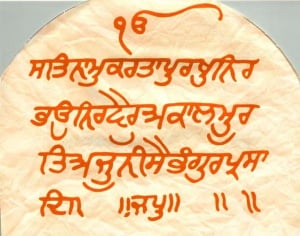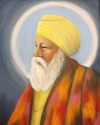Template:Today's featured article: Difference between revisions
Hari singh (talk | contribs) No edit summary |
Navroopsehmi (talk | contribs) No edit summary |
||
| Line 1: | Line 1: | ||
[[Image: | ==The Mool Mantar== | ||
[[Image:Moolmantar guruarjan.jpg|thumb|Mool Mantar in the handwriting of Guru Arjan Dev ji from the Kartarpuri Bir]] | |||
The Mool Mantar is the most important composition contained within the Sri [[Guru Granth Sahib]]; it is the basis of Sikhism. It’s importance is emphasised by the fact that it is the first composition to appear in the SGGS and that it appears before the commencement of most of the Raags within the SGGS. | |||
The Mool Mantar is said to be the first composition uttered by [[Guru Nanak]] Dev ji upon [[3 Days in the River|enlightenment]] at the age of 30. Being the basis of Sikhism it encapsulates the entire theology of Sikhism, and as a result, it is also the most difficult composition to fully understand. The proceeding [[Japji Sahib]] and the rest of the SGGS totalling 1430 pages, are efforts to explain that which is contained within the Mool Mantar. | |||
'''[[Mool Mantar|....Continued]]''' | |||
'''[[ | |||
---- | ---- | ||
Revision as of 07:45, 9 May 2005
The Mool Mantar
The Mool Mantar is the most important composition contained within the Sri Guru Granth Sahib; it is the basis of Sikhism. It’s importance is emphasised by the fact that it is the first composition to appear in the SGGS and that it appears before the commencement of most of the Raags within the SGGS.
The Mool Mantar is said to be the first composition uttered by Guru Nanak Dev ji upon enlightenment at the age of 30. Being the basis of Sikhism it encapsulates the entire theology of Sikhism, and as a result, it is also the most difficult composition to fully understand. The proceeding Japji Sahib and the rest of the SGGS totalling 1430 pages, are efforts to explain that which is contained within the Mool Mantar.
Guru Nanak (15 April 1469 - 7 May 1539),is the founder of Sikhism and the first of the ten Gurus of the Sikhs. He was born in the village of Talwandi also called Rai Bhoeki Talwandi, now known as Nankana Sahib, near Lahore in present-day Pakistan. He was born, according to all ancient Sikh records, in the early morning of the third day of the light half of the month of Baisakh (Apil-May) in the year 1469 AD; but for conveniance sake his anniversary is now observed by the Sikhs on the occaision of the full moon in the month of Kartik (October-November). Before Guru Nanak breathed his last in 1539, his name had travelled not only throughout India's north, south, east and west, but also far beyond into Arabia, Messopotania, Ceylon, Afghanistan, Burma and Tibet.


